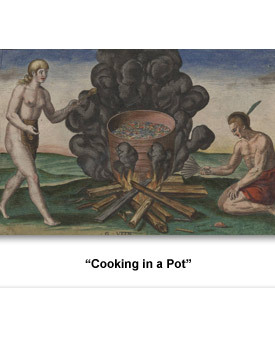Indians & Cultural Encounters
Pottery and Baskets
Women created ceramics and basketry. These were used in everyday life and for special ceremonial customs.
Pottery for everyday use was plain and made from gray or brown clay. Ceremonial ceramics were made from blue or white clay mixed with sand or crushed shells. The sand or shells helped to make the pottery stronger.
Indian women used pottery to make “very good Indian bread, baked in a curious manner,” according to Henry Timberlake, a British soldier who wrote about his travels among the Cherokee.
The women would build a fire on a pottery stone, about the size of a plate. After the fire was reduced to coals, the women would sweep off the stone and place dough on it. They then -cover-ed the dough with a large pot, and placed the coals back on top and around the pot. Timberlake said the bread “baked to as great perfection as in any European oven.”
The makers decorated pottery vessels by painting, cutting, marking with cords or fabric, or stamping them. Ceramic statues and effigies depicting both human and animal forms have been found in Tennessee along the Tennessee and Hiwassee Rivers.
Baskets also had uses that were practical, ceremonial, and creative. European observers as far back as Hernando de Soto described the unique designs and shapes of southeastern Indian basketry.
Baskets were made by weaving or coiling reeds or cane onto a cane structure. These materials were sometimes dyed with natural pigments and interwoven with natural strips to produce designs.
Cherokee women were especially skilled at making double-weave baskets. These baskets had two layers woven back to back so that the surface of the basket was smooth both inside and out.
Picture Credits:
- Print of a “Cherokee village” scene featuring a log hut at the center with other huts behind it. A river and other native villagers are also pictured. The painting depicts the Cherokee village of Toqua in Monroe County, Tennessee and was painted by Louis Philippe in the early 1800s. Tennessee State Museum Collection, 82.63.
- Drawing entitled, “Cooking in a Pot.” This image features a Native American woman and man tending a fire with a pot of food cooking on it. This image was originally drawn by John White and was included in the book A Briefe and True Report of the New Found Land of Virginia by Thomas Hariot. Later the image was engraved by G. Veen and reprinted in 1590. Some artists wanted to make Native Americans look more like Europeans, so he drew them with blonde hair and white skin. Although the drawing is not entirely accurate, it demonstrates how some Europeans did not understand or appreciate the ways in which Native Americans were different from them. The Indians pictured belong to the Southern Algonquian group of Indians, who are related to the Shawnee. North Carolina Collection, University of North Carolina.
Indians & Cultural Encounters >> Indian Life >> How They Worked >> Pottery and Baskets

 Sponsored by: National Endowment for the Humanities
Sponsored by: National Endowment for the Humanities